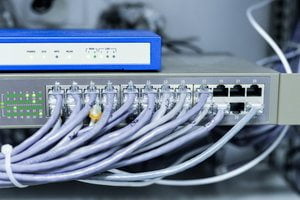Every ecommerce store needs to be hosted somewhere. But there’s little reason, in 2017, to self-host. In this post I’ll explain why.
Self-hosting is where a company acquires physical servers and installs them in its own data center. This could be a spare office, or rented space in another data center. Self-hosting is the original method for ecommerce stores. It is still done by larger enterprises, though it’s more rare by the day.
Flexibility vs. Responsibility
Self-hosting is the most flexible option because you can do whatever you want.
Want to use Apple OSX software for your store? You can.
Want to string together a bunch of inexpensive desktop machines into a cluster? You can.
You can do most anything you want with your own servers. That can sometimes be a good thing if you have specialized needs. But this control over every aspect of the servers can turn into a disadvantage.
You’re on the hook for all hardware malfunctions, software updates, and anything other computer or connection glitch. Even routine construction work could affect your store if, say, a nearby crew accidentally cut an Internet or electricity line.
That happened to me once, in fact, at a former employer. The power was cut for the part of the building that included the servers. We ended up stringing heavy-duty extension cables to the data center to keep the servers running. It was a mess. It was also dangerous. But that’s what we had to do to keep our site running.
Expense
Another thing to consider with self-hosting is the expense. Buying (or renting) servers and equipment can be a large capital outlay. Even if the day-to-day costs are lower than outsourced hosting options, the initial capital requirements could be prohibitive.
Moreover, with self-hosting you’ll need staff or consultants on premise to keep everything running. The developer skills to keep an ecommerce store up and functional are specialized — and expensive.
Capacity
When you self-host you have to ensure you have enough capacity to handle the traffic to your site. In practice, this means monitoring your servers to run at 80 percent or less of capacity, to handle traffic spikes without crashing the site.
If your company offers major sales, flash sales, or heavy marketing, you’ll likely need even more capacity — perhaps 50 percent of normal traffic needs — which means buying and maintaining more servers.
You’ll also need to accommodate changes in capacity requirements. It’s is not a static value. You’ll likely need to add or replace servers. To add a single server, you’ll need to:
- Order it;
- Have it shipped;
- Physically set it up;
- Install software;
- Add it to your store’s configuration.
Removing a server could be as simple as powering it down. But you’d still be out the capital outlay. And I’ve seen orders for new, replacement servers take months to fulfill.
Don’t Do It
In an age of Amazon Web Services and other affordable cloud hosting options, there’s little reason to self-host. Even large enterprises that could afford self-hosting are moving away from it.
A hybrid model where you don’t run the data center — called colocation — doesn’t make sense for most merchants, either.
In short, the benefit of having physical servers for your ecommerce store is not worth the money and the hassle. Just don’t do it.
